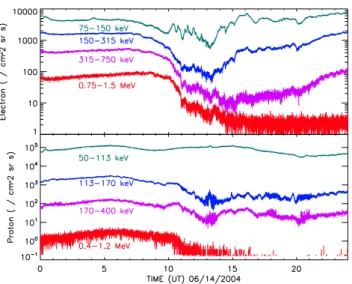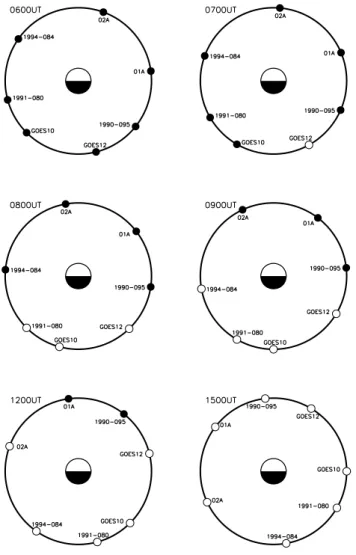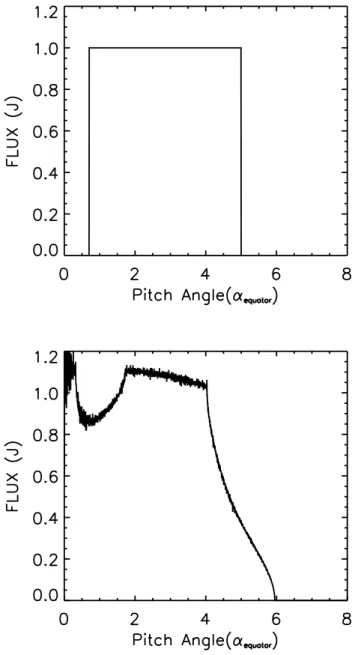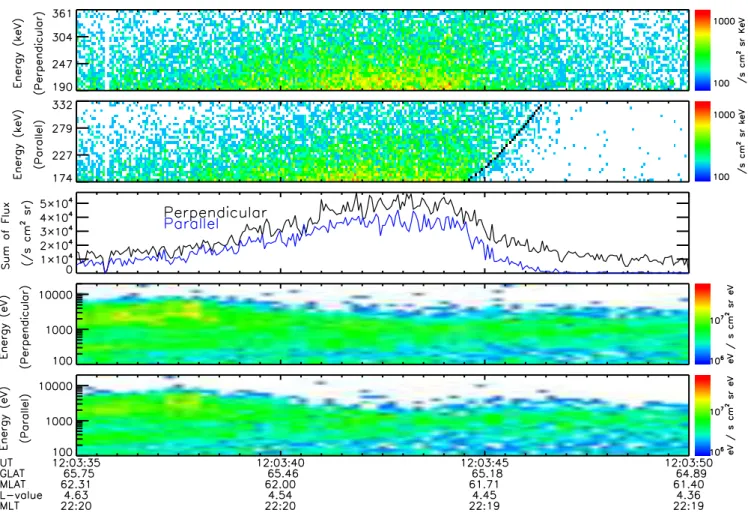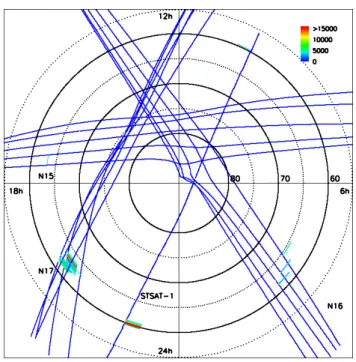www.ann-geophys.net/24/3151/2006/ © European Geosciences Union 2006
Annales
Geophysicae
Relativistic electron dropouts by pitch angle scattering in the
geomagnetic tail
J. J. Lee1, G. K. Parks1, K. W. Min2, M. P. McCarthy3, E. S. Lee1, H. J. Kim2, J. H. Park2, and J. A. Hwang2
1Space Sciences Lab., University of California, Berkeley, CA, USA
2Department of Physics, Korea Advanced Institute of Science and Technology, Daejeon, Korea 3Geophysics Program, University of Washington, Seattle, USA
Received: 5 June 2006 – Revised: 22 August 2006 – Accepted: 13 October 2006 – Published: 22 November 2006
Abstract. Relativistic electron dropout (RED) events are characterized by fast electron flux decrease at the geostation-ary orbit. It is known that the main loss process is non adia-batic and more effective for the high energy particles. RED events generally start to occur at midnight sector and prop-agate to noon sector and are correlated with magnetic field stretching. In this paper, we discuss this kind of event can be caused from pitch angle diffusion induced when the gyro radius of the electrons is comparable to the radius of curva-ture of the magnetic field and the magnetic moment is not conserved any more. While this process has been studied theoretically, the question is whether electron precipitation could be explained with this process for the real field config-uration. This paper will show that this process can success-fully explain the precipitation that occurred on 14 June 2004 observed by the low-altitude (680 km) polar orbiting Korean satellite, STSAT-1. In this precipitation event, the energy dispersion showed higher energy electron precipitation oc-curred at lower L values. This feature is a good indicator that precipitation was caused by the magnetic moment scattering in the geomagnetic tail. This interpretation is supported by the geosynchronous satellite GOES observations that showed significant magnetic field distortion occurred on the night side accompanying the electron flux depletion. Tsyganenko-01 model also shows the magnetic moment scattering could occur under the geomagnetic conditions existing at that time. We suggest the pitch angle scattering by field curvature vio-lating the first adiabatic invariant as a possible candidate for loss mechanism of relativistic electrons in radiation belt. Keywords. Magnetospheric physics (Energetic particles, precipitating; Energetic particles, trapped; Magnetotail)
Correspondence to:J. J. Lee (jjlee@ssl.berkeley.edu)
1 Introduction
Many spacecraft failures and anomalies have been attributed to relativistic electrons (sometimes referred to as “killer elec-trons”) in the Earth’s magnetosphere (Baker, 2000). An ex-ample of such failures is caused by the spacecraft internal charging (Garrett and Whittlesey, 2000). High energy elec-trons can penetrate the thick shielding and bury themselves in the insulation around sensitive satellite electronics. Charges from these accumulating electrons build up in the spacecraft, and a strong internal electrical discharge can occur to de-stroy electric devices. Not surprisingly, understanding them has been one of top issues since early space era.
While the dynamics of these electrons have been studied extensively for several decades, the fundamental questions as to how they are produced and lost are still not fully re-solved (Friedel et al., 2002). Electrons within Earth’s magne-tosphere come from two main sources, the solar wind and the Earth’s ionosphere. However, these two sources provide low energy electrons, 1 eV and 10 eV for each. These values are too small to explain the high population of relativistic elec-trons with energies∼100 keV to>15 MeV (Li and Temerin, 2001).
Regarding the question of how they are lost, there are two kinds of loss processes, adiabatic and non-adiabatic. The adiabatic processes, such as the magnetopause shadowing and Dst effect, do not represent real losses, because the
3152 J. J. Lee et al.: Relativistic electron dropouts
Fig. 1. Electron (top) and proton (bottom) flux observed by LANL-02A on 14 June 2004.
The electron flux level in the magnetosphere at any time is determined by a competition between acceleration and loss process. The electron fluxes are commonly observed to de-crease during the main phase of a storm, and then may in-crease to well above the prestorm levels during or shortly af-ter the recovery phase of the storm(Nagai, 1988; Kim et al., 2006). Yet in some cases, electron fluxes are not recovered and remained low flux level(Reeves et al., 2003). Onsager et al. (2002) investigated the flux level at geosynchronous altitudes in response to a moderate (−80 nTDst) magnetic
storm (16 April 2000). They found that the>2 MeV elec-trons decrease fairly abruptly but not simultaneously at dif-ferent local times and the flux level did not increase during the recovery time. These events are known as RED (Rel-ativistic Electron Dropout) events. They also showed that the lower energy electrons<300 keV recover fully while the >2 MeV electrons are permanently lost.
Green et al. (2004) studied three possible causes of the en-suing flux decrease: adiabatic electron motion in response to the changing magnetic flux topology, drift of the guiding center out the magnetopause boundary, and precipitation into the atmosphere. Although the adiabatic motion may be a sat-isfactory explanation for the local time dependence of the flux levels and partly contributed to electron flux decrease, their analysis revealed that electron flux dropouts are likely due to enhanced precipitation into the atmosphere. These flux dropouts showed a good correlation with the stretch-ing of the magnetic field to a more tail-like configuration. Recently, Clilverd et al. (2006) observed large-scale precip-itation into the atmosphere during the sudden decrease of geosynchronous electron flux (>2 MeV). However, their in-direct observation of precipitation with ground-based iono-spheric measurements doesn’t show clearly the correlation
between RED events and electron precipitations. In this pa-per, we use in-situ data to demonstrate a RED event can cause particle precipitation.
It has been known that the increased field line curvature on stretched field lines could lead to the breaking of the first adi-abatic invariant which can lead to precipitation of particles. Proton isotropic boundary might be explained by the proton precipitation due to magnetic moment scattering (Sergeev and Gvozdevsky, 1995). Friedel et al. (2002) stated “While this certainly can occur for protons, can this be a process for highly relativistic electrons also? Research in this area is ongoing.” While the idea that magnetic moment scatter-ing can lead to particle precipitation has been studied theo-retically (Delcourt and Martin, 1994; Buechner and Zelenyi, 1989; Chen and Palmadesso, 1986), observational analysis has not made much progress. This is because it is difficult to identify the various sources of precipitation. Imhof et al. (1977) observed energy dispersion of precipitating electrons at the trapping boundary and interpreted that these events might occur from the violation of the first adiabatic invariant (Imhof et al., 1979, 1997; Imhof, 1988). Popielawska and Zwolakowska (1991) used Tsyganenko-87 and -89 model to reproduce the observed sharp decrease of threshold energy with increasing L. While their results show some agreements with measurements in latitude where isotropic precipitation was expected to occur, the very steep profiles of energy dis-persion were not well explained. This paper will show the energy dispersion structures can indeed be reproduced with Tsyganenko-01 model using energetic electron data mea-sured by STSAT-1. We estimate how fast electrons can be lost with a simple test particle simulation. Our results sup-port the idea that this process can produce relativistic elec-tron dropouts at the geostationary orbit and can help in the development of a comprehensive model of relativistic elec-tron dynamics to forecast space weather.
2 Relativistic electron dropouts
An example of relativistic electron dropouts shown in the top panel of Fig. 1 was observed by the geostationary satellite, LANL-02A on 14 June 2004 in the energy range from 75 keV to 1.5 MeV. Note that the 0.75∼1.5 MeV electron flux de-creases were observed for∼5 h at a level that is less than one tenth of the previous flux, while the lower energy (∼100 keV) electron flux recovered after ∼1 h. The flux drop out re-mained until 15 June and then slowly recovered to the previ-ous level. As shown in the bottom panel of Fig. 1, the proton flux also decreased concurrent with the electrons. This fig-ure demonstrates that the loss process is more effective for the higher energy electrons and protons.
Fig. 2. Local time progression of electron flux dropouts observed by seven geosynchronous spacecraft. Black circles indicate high level flux, while open circles shows electron flux dropouts.
levels, respectively. All satellites observed high electron flux at 06:00 UT, but GOES12 first observed electron dropout be-tween 06:00 and 07:00 UT. This dropout was fairly local-ized as can be seen by the fact that two satellites, GOES 10 and 1990-095 which were separated by 4 h and 3 h in local time from GOES12, didn’t see the flux dropout. Somewhat later, electron dropout started to be detected by other satel-lites and propagated to noon sector from midnight. This re-sult is a little different from Onsager et al. (2002) in which the electron dropout was observed first at dusk (15:00 LT). However, these observations are consistent with the statisti-cal results of Green et al. (2004) who analyzed statististatisti-cally 52 flux decreases and showed the electron flux is reduced first in the dusk sector (15:00 LT∼24:00 LT) concurrent with the stretching of the magnetic field. Also their superposed epoch plot showed electron depletion started most frequently around 22:00 LT and propagated to all local times after 8 h.
Fig. 3. Geomagnetic field observed by GOES-10(top), IMF Bz (second) and solar wind pressure measured by WIND andDstindex
from 13 to 14 June 2004.
The time required for the dropout to be detected at all lo-cal times (∼8 h) was much longer than 5 to 10-min drift pe-riod of the electrons. This implies the dropout did not occur through the depletion of the drift shells, but rather due to the distortion of the drift shells (Onsager et al., 2002).
Green et al. (2004) showed electron dropout is correlated with geomagnetic field stretching. The top panel of Fig. 3 shows the geomagnetic field measured by the geostationary satellite, GOES-10, from 13 to 14 June. The red line incates earthward direction and green line shows parallel di-rection to the satellite spin axis, approximately +Z in GSM coordinate. Comparing to the magnetic field data observed on 13 June, the earthward magnetic field was much enhanced while +Z direction field strength decreased at 12:00 UT on 14 June. Because GOES-10 passed through the midnight sector at 09:20 UT, this field data imply the geomagnetic field was stretched to more tail-like geometry at the night time. Superposed epoch analysis performed by Green et al. (2004) shows electron dropout events are observed preced-ing quiet condition, occurs with solar wind pressure enhance-ment, southward turning ofBz, decrease ofDst and increase
3154 J. J. Lee et al.: Relativistic electron dropouts
Fig. 4. Electron trajectories for field lines having four differentκ, 2.56 (black), 1.52 (blue), 0.91 (red) and 0.27 (purple).
on 14 June, WIND measured strong southward IMF Bz, al-most −10 nT, and enhanced solar wind pressure as shown in the second and third panels of Fig. 3. The bottom panel of the Fig. 3 shows theDst index decreased from 15 nT to
−30 nT. These variations of geophysical indices however do not explain how the dramatic change of magnetic fields are produced. Nor is it clear how these variations can produce field line stretching. The following summarizes the electron dropout characteristics.
1. Fast dropouts last for 1∼5 h
2. Observed for both of electrons and protons 3. More effective for higher energy charged particles 4. Started from dusk and midnight sector and propagate to
noon sector
5. Correlation with magnetic field stretching
3 Pitch angle scattering by field curvature
The violation of the first adiabatic invariant has strict con-straint for electrons in the magnetosphere because it requires perturbation with time scales of one gyro period. However, the first adiabatic invariant can be violated if the radius of magnetic field curvature is comparable to the electron gyro radius (Chen and Palmadesso, 1986; Buechner and Zelenyi, 1989; Delcourt and Belmont, 1998). This is because during one gyro motion, an electron experiences significant mag-netic field changes that cause pitch-angle changes so particles enter the loss cone. This magnetic moment scattering is char-acterized byκ=[Rc/ρ]1/2, whereRcis the minimum radius
of magnetic field curvature andρis the particle’s maximum gyro radius. It’s not easy to define clearly theκ values for real magnetic field, because the field has three dimensional configuration and depends on location. For a parabolic field model, B(z)=bxLzxˆ+bzz, we defineˆ κ as above, evaluated
for a charged particle atz=0 where the radius of curvature is minimum. In this case, the radius of curvature isLbz/bxand
the gyro radius isp/(qbz)withp andq the particle’s
mo-mentum and charge (Delcourt and Belmont, 1998). Figure 4 shows how the electron trajectories depend onκfor four dif-ferent values. The electron trajectories were calculated by solving the Lorentz equation for a parabolic field model, and electrons were launched from south to north with 30◦initial pitch angle. For threeκvalues, 2.56 (black), 1.52 (blue) and 0.91 (red), 1 MeV test electrons were used and for theκvalue of 0.27 (purple), we used 15 MeV electrons.
The results indicate that for the line(black) having the largest radius of curvature, the terminal pitch angle is ex-actly same as the initial pitch angle. Here aκvalue of 2.56 is slightly larger than the value needed for electrons to undergo non-adiabatic motion. For the field (blue line) having smaller radius of curvature, electrons start to change their pitch an-gles during the passage through the field reversal region. The final pitch angle can be larger or smaller than initial pitch angle. And some electrons can have very small pitch an-gles, aligned along the field lines as shown in Fig. 4. For a detailed description about pitch angle scattering, see Del-ccourt’s papers (Delcourt et al., 1996, 2004; Delcourt and Belmont, 1998; Delcourt and Martin, 1999).
As the radius of field line curvature decreases, the final pitch angle range that electrons can have increases. When κ is 0.91, some electrons having 30◦initial pitch angle can have 90◦ pitch angle near the equator and move back and forth as chaotic motion (red line). Finally these electrons can be aligned to the magnetic field then precipitate into the atmosphere. For the smallest radius of curvature in Fig. 4, the electron motion (purple line), κ is 0.27. If κ is much smaller than unity, particles may experience meandering mo-tion about the field minimum as shown by Speiser (1965). Because electrons have small gyro radius, in the real mag-netosphere field line, it is hard for electrons to follow the motions described by red or purple lines. We assumed elec-trons can be lost by only the pitch angle scattering described by blue line in Fig. 4.
magnetic moment is conserved. The bottom panel of Fig. 5 shows how the pitch angle distribution changed after just one pass through the equator. Note the electron flux in the loss cone increased to almost the same level as outside of the loss cone, which means the loss cone was filled by a strong pitch angle scattering process. With this process, 0.0075% elec-trons should be lost by precipitation for half bouncing mo-tion. Here we assumed pitch angle distribution is uniform at the outside of loss cone. Because only electrons within 1◦ from the loss cone can diffuse into loss cone, loss rate depends on how many times they pass through equatorial re-gion where magnetic moment scattering occurs. The diffu-sion of electrons away from the loss cone contributes to keep-ing uniform pitch angle distribution and supplies electrons to the region near loss cone. The loss rate can be calculated from the equation,dF /dt=(−2×0.000075)F /TB, where F
is electron flux andTBis a bouncing period. The time taken
to reduce the electron flux from the equatorial region of the radiation belt by a factor of 1/e isTB/(2×0.000075).
Assum-ing 1 MeV electrons travel 20 Re for one bouncAssum-ing motion, TBis about 425 ms. Assuming electron precipitation occurs
in the region of 90◦in longitude (25% of a drift circle), our rough calculation shows it takes just 3.1 h to empty radiation belts.
4 Observations of electron precipitation
The pitch angle scattering by the field line curvature can explain many features of electron dropouts. First, we cal-culated it takes about 3.1 h to empty an electron flux tube from the radiation belt. This can explain reasonably well the geostationary spacecraft observations of large and fast flux dropouts that takes several hours. The magnetic moment scattering process by field line curvature is more effective for high energy electrons, which can explain why low en-ergy electron dropout is not observed. The magnetic field curvature scattering is most important in the region where field curvature radius is minimum which might correspond to midnight sector and far away from the earth. Thus large L shell electrons can escape more easily. This can explain the observations that electron dropouts begin near midnight and propagate to noon sector. Some other observations, On-sager et al. (2002) in which electron dropouts start from dusk side can be explained by the formation of a partial ring cur-rent driven by changing solar wind conditions (Green et al., 2004). Moreover, this process is effective for both protons and electrons. If 1 MeV electrons had κ of 1.52, 1 MeV proton would haveκ of 0.27 for the same field configura-tion. Thus, the same energy electrons and protons undergo very different motions. Nevertheless, both of them have a chance to precipitate into the Earth’s atmosphere by pitch angle scattering ifκis smaller than the critical value of about 2.5 as shown in Fig. 4. Yet significant proton flux drop is not commonly observed in the low energy region (Fig. 1).
Fig. 5. Loss cone filling by pitch angle scattering. Initial pitch an-gle distribution (top), changed pitch anan-gle distribution after passing through field reversal (bottom).
This is possibly due to the fact that the particle’s loss rate depends on the number passing through the field reversal re-gion. The gyro radius of 100 keV protons is ten times larger than 1 MeV electrons, but the velocity is just 1.5% of elec-trons. This means that it takes longer time to deplete protons as electrons.
3156 J. J. Lee et al.: Relativistic electron dropouts
Fig. 6. Energetic electron precipitations observed by STSAT-1 on 14 June 2004. The black line in the second panel indicates energy dispersion calculated in Fig. 7.
STSAT-1. STSAT-1 was launched on 27 September 2003 into a sun synchronous low altitude (680 km) orbit. STSAT-1 instrumentation included the Far-ultraviolet Imaging Spec-trograph (FIMS), an Electro-Static Analyzer (ESA), Solid State Telescopes (SST), a Langmuir Probe (LP) and Sci-entific Magnetometer (SM). FIMS is an astrophysical in-strument while the latter four are space physics experiment. These four instruments operate simultaneously in the polar region.
SST has two solid state detectors to measure energy spec-tra of electrons between 170 keV∼360 keV . Each detector has a field of view of 33.9◦, one is parallel and the other is perpendicular to the Earth magnetic field. Because the atmo-spheric loss cone at 680 km is about 60◦, the perpendicular SST detects trapped electrons mirroring at the satellite alti-tude while the parallel SST which looks upward detect pre-cipitated electrons. The top two panels show differential en-ergy spectra from the perpendicular and parallel SSTs. The third panel shows the total electron fluxes in the energy mea-sured by the SSTs in the two directions. For comparison with
the SST electrons, the perpendicular and parallel components of energy flux spectrograms measured by Electrostatic Ana-lyzer (ESA) are shown in the bottom two panels. A detailed description of the instruments is in Lee et al. (2005).
Fig. 7. The radius of magnetic field curvature and threshold energy derived from Tsyganenko01 model.
In Fig. 7, the magnetic field curvatures and threshold en-ergies are plotted for the magnetic latitude of interest. The threshold energy is defined by the energy corresponding toκ of 2.5 which can induce electron loss by pitch angle scatter-ing. The rectangular box shows the energy range measured by STSAT-1 parallel SST, 170 keV∼330 keV and the corre-sponding threshold energy. We derived approximately the ra-dius of curvature from Tsyganenko-01 model where the input parameters used wereDst index of−33 nT, solar wind
pres-sure of 2.81 nPa, IMF By of 7.25 nT and Bz of −9.10 nT. These values are slightly different from real measurements where Dst index was −20 nT and IMF Bz was −7.1 nT.
These solar wind and IMF data were measured by WIND at 11:00 UT, whileDst were measured at 12:00 UT. The time
difference of 1 h is the time for solar wind whose velocity is 400 km/s to reach the Earth from the WIND spacecraft which was located at−214 Re along X (GSE coordinate). Actually we had some difficulties in selecting these parameters, be-cause there were fluctuations (Fig. 3), and ACE and WIND showed somewhat different data. Considering Tsyganenko model is a statistical model, we think these changes of IMF Bz andDst index are reasonably applicable in modeling the
magnetic field on 14 June. Figure 7 reproduces extremely well the energy dispersion observed by STSAT-1 where the dispersion appeared from 61.72◦to 61.84◦ in geomagnetic latitude, which is the same as the result obtained from Tsy-ganenko model. We showed this dispersion in Fig. 6 with black line. This result strongly suggests that electrons were precipitated on 14 June by the field curvature magnetic mo-ment scattering.
Fig. 8. Electron precipitations observed by four spacecraft, NOAA/POES N15, N16, N17 and STSAT-1.
Our results strongly support the idea that pitch angle scat-tering by curvature contributes to the electron flux dropouts. However, we do not exclude other precipitation mecha-nisms, such as a non-adiabatic loss process, e.g. precipita-tion by wave and particle interacprecipita-tions. It has been known that electrons in the magnetosphere can interact with elec-tron cycloelec-tron harmonic waves (ECH) (Horne and Thorne, 2000), electromagnetic ion cyclotron waves (EMIC) (Sum-mers and Thorne, 2003; Albert, 2003; Lorentzen et al., 2000; Horne and Thorne, 1998), and whistler waves (Lorentzen and Blake, 2001). These waves are generally observed in differ-ent local time sectors. ECH waves are predominantly seen in the midnight to dawn region of magnetosphere associated with substorm injections. EMIC waves occur in the dusk re-gion where the ratio between the plasma frequency and elec-tron gyro frequency is high, and whistler waves are observed in the dawn sector.
3158 J. J. Lee et al.: Relativistic electron dropouts 14 June is unlikely to be caused by EMIC or whistler mode
waves, because these waves are confined to the dusk and dawn regions. At the present time, there are no wave particle interaction theories that can generate the energy dependent electron flux dropouts as seen by STSAT-1.
5 Conclusions
In this paper, we showed precipitation produced by field cur-vature can explain well the characteristics of relativistic elec-tron dropout events observed on 14 June 2004. While this event showed a slow recovery, it is important to note that electron dropout events are usually accompanied with sudden electron enhancements. Thus we need to understand acceler-ation and loss mechanisms to develop a model of relativistic electron dynamics to forecast space weather. In conclusion, the pitch angle scattering induced by field curvature should be viewed as a serious candidate for loss mechanisms of rel-ativistic electrons in the radiation belt.
Acknowledgements. This work is supported by a NASA grant NAG5-11416. We would like to thank all engineers at SaTReC for contributing to successful operation of scientific mission of STSAT-1.
Topical Editor I. A. Daglis thanks S. Bourdarie and another ref-eree for their help in evaluating this paper.
References
Albert, J. M.: Evaluation of quasi-linear diffusion coefficients for EMIC waves in a multispecies plasma, J. Geophys. Res., 108, 16–1, doi:10.1029/2002JA009792, 2003.
Baker, D.: The occurrence of operational anomalies in spacecraft and their relationship to space weather, IEEE Trans. Plasma Sci, 28, 2007–2016, 2000.
Buechner, J. and Zelenyi, L. M.: Regular and chaotic charged parti-cle motion in magnetotaillike field reversals. I – Basic theory of trapped motion, J. Geophys. Res., 94, 11 821–11 842, 1989. Chen, J. and Palmadesso, P. J.: Chaos and nonlinear dynamics of
single-particle orbits in a magnetotaillike magnetic field, J. Geo-phys. Res., 91, 1499–1508, 1986.
Clilverd, M. A., Rodger, C. J., and Ulich, T.: The importance of atmospheric precipitation in storm-time relativistic electron flux drop outs, Geophys. Res. Lett., 33, L1102, doi:10.1029/ 2005GL024661, 2006.
Delcourt, D. C. and Belmont, G.: Particle Dynamics in the Near-Earth Magnetotail and Macroscopic Consequences, in: New Per-spectives on the Earth’s Magnetotail, edited by: Nishida, A., Baker, D. N., and Cowley, S. W. H., pp. 193–210, 1998. Delcourt, D. C. and Martin, R. F.: Application of the centrifugal
impulse model to particle motion in the near-Earth magnetotail, J. Geophys. Res., 99, 23 583–23 590, 1994.
Delcourt, D. C. and Martin, R. F.: Pitch angle scattering near energy resonances in the geomagnetic tail, J. Geophys. Res., 104, 383– 394, doi:10.1029/1998JA900041, 1999.
Delcourt, D. C., Sauvaud, J.-A., Martin, R. F., and Moore, T. E.: On the nonadiabatic precipitation of ions from the
near-Earth plasma sheet, J. Geophys. Res., 101, 17 409–17 418, doi:10.1029/96JA01006, 1996.
Delcourt, D. C., Malova, H. V., and Zelenyi, L. M.: Dynamics of charged particles in bifurcated current sheets: Theκ˜ 1 regime, J. Geophys. Res., 109, A01 222, doi:10.1029/2003JA010167, 2004.
Desorgher, L., B¨uhler, P., Zehnder, A., and Fl¨uckiger, E. O.: Simu-lation of the outer radiation belt electron flux decrease during the March 26, 1995, magnetic storm, J. Geophys. Res., 105, 21 211– 21 224, doi:10.1029/2000JA900060, 2000.
Dessler, A. J. and Karplus, R.: Some Effects of Diamagnetic Ring Currents on Van Allen Radiation, J. Geophys. Res., 66, 2289– 2296, 1961.
Friedel, R. H. W., Reeves, G. D., and Obara, T.: Relativistic electron dynamics in the inner magnetosphere – a review, J. Atmos. Terr. Phys., 64, 265–282, 2002.
Garrett, H. B. and Whittlesey, A. C.: Spacecraft charging, An up-date, IEEE Trans. Plasma Sci, 28, 20 017–2028, 2000.
Green, J. C., Onsager, T. G., O’Brien, T. P., and Baker, D. N.: Testing loss mechanisms capable of rapidly depleting relativis-tic electron flux in the Earth’s outer radiation belt, J. Geophys. Res., 109, A12 211, doi:10.1029/2004JA010579, 2004. Horne, R. B. and Thorne, R. M.: Potential waves for
rel-ativistic electron scattering and stochastic acceleration dur-ing magnetic storms, Geophys. Res. Lett., 25, 3011–3014, doi:10.1029/98GL01002, 1998.
Horne, R. B. and Thorne, R. M.: Electron pitch angle diffusion by electrostatic electron cyclotron harmonic waves: The ori-gin of pancake distributions, J. Geophys. Res., 105, 5391–5402, doi:10.1029/1999JA900447, 2000.
Imhof, W. L.: Fine resolution measurements of the L-dependent en-ergy threshold for isotropy at the trapping boundary, J. Geophys. Res., 93, 9743–9752, 1988.
Imhof, W. L., Reagan, J. B., and Gaines, E. E.: Fine-scale spa-tial structure in the pitch angle distributions of energetic parti-cles near the midnight trapping boundary, J. Geophys. Res., 82, 5215–5221, 1977.
Imhof, W. L., Reagan, J. B., and Gaines, E. E.: Studies of the sharply defined L dependent energy threshold for isotropy at the midnight trapping boundary, J. Geophys. Res., 84, 6371–6384, 1979.
Imhof, W. L., Chenette, D. L., Gaines, E. E., and Winning-ham, J. D.: Characteristics of electrons at the trapping bound-ary of the radiation belt, J. Geophys. Res., 102, 95–104, doi:10.1029/96JA02797, 1997.
Kim, H.-J. and Chan, A. A.: Fully adiabatic changes in storm time relativistic electron fluxes, J. Geophys. Res., 102, 22 107–22 116, doi:10.1029/97JA01814, 1997.
Kim, H.-J., Kim, K. C., Lee, D.-Y., and Rostoker, G.: Origin of geosynchronous relativistic electron events, J. Geophys. Res., 111, A03 208, doi:10.1029/2005JA011469, 2006.
Lee, J.-J., Parks, G. K., Min, K. W., Kim, H. J., Park, J., Hwang, J., McCarthy, M. P., Lee, E., Ryu, K. S., Lim, J. T., Sim, E. S., Lee, H. W., Kang, K. I., and Park, H. Y.: Energy spectra of ˜170-360 keV electron microbursts measured by the Korean STSAT-1, Geophys. Res. Lett., 32, L13 106, doi:10.1029/2005GL022996, 2005.
Lorentzen, K. R. and Blake, J. B.: Observations of relativistic elec-tron microbursts in association with VLF chorus, J. Geophys. Res., 106, 6017–6027, 2001.
Lorentzen, K. R., McCarthy, M. P., Parks, G. K., Foat, J. E., Mil-lan, R. M., Smith, D. M., Lin, R. P., and Treilhou, J. P.: Precip-itation of relativistic electrons by interaction with electromag-netic ion cyclotron waves, J. Geophys. Res., 105, 5381–5390, doi:10.1029/1999JA000283, 2000.
Nagai, T.: ‘Space weather forecast’ – Prediction of relativistic elec-tron intensity at synchronous orbit, Geophys. Res. Lett., 15, 425– 428, 1988.
Onsager, T. G., Rostoker, G., Kim, H.-J., Reeves, G. D., Obara, T., Singer, H. J., and Smithtro, C.: Radiation belt electron flux dropouts: Local time, radial, and particle-energy dependence, J. Geophys. Res., 107, 21–1, doi:10.1029/2001JA000187, 2002. Popielawska, B. and Zwolakowska, D.: An assessment of a
magne-tospheric model by tracing the energetic particle trapping bound-ary, Geophys. Res. Lett., 18, 1489–1492, 1991.
Reeves, G. D., Friedel, R. H. W., Belian, R. D., Meier, M. M., Hen-derson, M. G., Onsager, T., Singer, H. J., Baker, D. N., Li, X., and Blake, J. B.: The relativistic electron response at geosyn-chronous orbit during the January 1997 magnetic storm, J. Geo-phys. Res., 103, 17 559–17 570, doi:10.1029/97JA03236, 1998.
Reeves, G. D., McAdams, K. L., Friedel, R. H. W., and O’Brien, T. P.: Acceleration and loss of relativistic electrons during geomagnetic storms, Geophys. Res. Lett., 30, 36–1, doi:10.1029/2002GL016513, 2003.
Sergeev, V. A. and Gvozdevsky, B. B.: MT-index – a possible new index to characterize the magnetic configuration of magnetotail, Ann. Geophys., 13, 1093–1103, 1995,
http://www.ann-geophys.net/13/1093/1995/.
Speiser, T. W.: Particle Trajectories in a Model Current Sheet, Based on the Open Model of the Magnetosphere, with Appli-cations to Auroral Particles, J. Geophys. Res., 70, 1717–1728, 1965.
Summers, D. and Thorne, R. M.: Relativistic electron pitch-angle scattering by electromagnetic ion cyclotron waves during geomagnetic storms, J. Geophys. Res., 108, 2–1, doi:10.1029/2002JA009489, 2003.
Tsyganenko, N. A.: A model of the near magnetosphere with a dawn-dusk asymmetry 2. Parameterization and fitting to observa-tions, J. Geophys. Res., 107, 10–1, doi:10.1029/2001JA000220, 2002.
